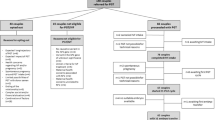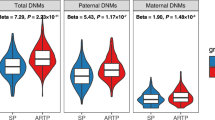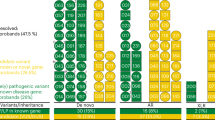Abstract
Preimplantation genetic diagnosis (PGD) is an option for couples at risk of having offspring with an inherited debilitating or fatal neurological disorder who wish to conceive a healthy child. PGD has been carried out for conditions with various modes of inheritance, including spinal muscular atrophy, Huntington disease, fragile X syndrome, and chromosomal or mitochondrial disorders, and for susceptibility genes for cancers with nervous system involvement. Most couples at risk of transmitting a genetic mutation would opt for PGD over prenatal testing and possible termination of a pregnancy. The aim of this Perspectives article is to assist neurologists in counselling and treating patients who wish to explore the option of PGD to enable conception of an unaffected child. PGD can be accomplished for most disorders in which the genetic basis is known, and we argue that it is time for clinicians and neurological societies to consider the evidence and to formulate guidelines for the responsible integration of PGD into modern preventative neurology.
This is a preview of subscription content, access via your institution
Access options
Subscribe to this journal
Receive 12 print issues and online access
$209.00 per year
only $17.42 per issue
Buy this article
- Purchase on Springer Link
- Instant access to full article PDF
Prices may be subject to local taxes which are calculated during checkout


Similar content being viewed by others
References
Andersen, P. M. & Al-Chalabi, A. Clinical genetics of amyotrophic lateral sclerosis: what do we really know? Nat. Rev. Neurol. 7, 603–615 (2011).
Pfeffer, G. et al. New treatments for mitochondrial disease—no time to drop our standards. Nat. Rev. Neurol. 9, 474–481 (2013).
Bechtel, K. & Geschwind, M. D. Ethics in prion disease. Prog. Neurobiol. 110, 29–44 (2013).
Simonato, M. et al. Progress in gene therapy for neurological disorders. Nat. Rev. Neurol. 9, 277–291 (2013).
Offit, K., Sagi, M. & Hurley, K. Preimplantation genetic diagnosis for cancer syndromes: a new challenge for preventive medicine. JAMA 296, 2727–2730 (2006).
Soini, S. et al. The interface between assisted reproductive technologies and genetics: technical, social, ethical and legal issues. Eur. J. Hum. Genet. 14, 588–645 (2006).
Tur-Kaspa, I., Aljadeff, G., Rechitsky, S., Grotjan, H. E. & Verlinsky, Y. PGD for all cystic fibrosis carrier couples: novel strategy for preventive medicine and cost analysis. Reprod. Biomed. Online 21, 186–195 (2010).
Handyside, A. H., Kontogianni, E. H., Hardy, K. & Winston, R. M. Pregnancies from biopsied human preimplantation embryos sexed by Y-specific DNA amplification. Nature 344, 768–770 (1990).
Verlinsky, Y. et al. Analysis of the first polar body: preconception genetic diagnosis. Hum. Reprod. 5, 826–829 (1990).
Platteau, P. et al. Preimplantation genetic diagnosis for fragile Xa syndrome: difficult but not impossible. Hum. Reprod. 17, 2807–2812 (2002).
Kuliev, A. & Rechitsky, S. Polar body-based preimplantation genetic diagnosis for Mendelian disorders. Mol. Hum. Reprod. 17, 275–285 (2011).
Handyside, A. H. Preimplantation genetic diagnosis after 20 years. Reprod. Biomed. Online 21, 280–282 (2010).
Harper, J. C. & Sengupta, S. B. Preimplantation genetic diagnosis: state of the art 2011. Hum. Genet. 131, 175–186 (2012).
Tur-Kaspa, I. Clinical management of in vitro fertilization with preimplantation genetic diagnosis. Semin. Reprod. Med. 30, 309–322 (2012).
Harper, J. C. et al. The ESHRE PGD Consortium: 10 years of data collection. Hum. Reprod. Update 18, 234–247 (2012).
Verlinsky, Y., Rechitsky, S., Verlinsky, O., Masciangelo, C., Lederer, K. & Kuliev, A. Preimplantation diagnosis for early-onset Alzheimer disease caused by V717L mutation. JAMA 287, 1018–1021 (2002).
Uflacker, A., Doraiswamy, M., Rechitsky, S., See, T., Geschwind, M. & Tur-Kaspa, I. Preimplanation genetic diagnosis (PGD) for genetic prion disorder due to F198S mutation in the PRNP gene. JAMA Neurol. http://dx.doi.org/10.1001/jamaneurol.2013.5884.
Altarescu, G. et al. Preimplantation genetic diagnosis (PGD) for nonsyndromic deafness by polar body and blastomere biopsy. J. Assist. Reprod. Genet. 26, 391–397 (2009).
Practice Committee of Society for Assisted Reproductive Technology & Practice Committee of American Society for Reproductive Medicine. Preimplantation genetic testing: a Practice Committee opinion. Fertil. Steril. 90, S136–S143 (2008).
Ethics Committee of American Society for Reproductive Medicine. Use of preimplantation genetic diagnosis for serious adult onset conditions: a committee opinion. Fertil. Steril. 100, 54–57 (2013).
Preimplantation Genetic Diagnosis International Society (PGDIS). Guidelines for good practice in PGD: programme requirements and laboratory quality assurance. Reprod. Biomed. Online 16, 134–147 (2008).
Audibert, F. et al. Preimplantation genetic testing. J. Obstet. Gynaecol. Can. 31, 761–775 (2009).
Harton, G. et al. ESHRE PGD consortium best practice guidelines for organization of a PGD centre for PGD/preimplantation genetic screening. Hum. Reprod. 26, 14–24 (2011).
de Die-Smulders, C. E., de Wert, G. M., Liebaers, I., Tibben, A. & Evers-Kiebooms, G. Reproductive options for prospective parents in families with Huntington's disease: clinical, psychological and ethical reflections. Hum. Reprod. Update 19, 304–315 (2013).
Hellebrekers, D. M. et al. PGD and heteroplasmic mitochondrial DNA point mutations: a systematic review estimating the chance of healthy offspring. Hum. Reprod. Update 18, 341–349 (2012).
Sallevelt, S. C. et al. Preimplantation genetic diagnosis in mitochondrial DNA disorders: challenge and success. J. Med. Genet. 50, 125–132 (2013).
Klitzman, R. et al. Views of internists towards uses of PGD. Reprod. Biomed. Online 26, 142–147 (2013).
Brandt, A. C. et al. Knowledge, attitudes, and clinical experience of physicians regarding preimplantation genetic diagnosis for hereditary cancer predisposition syndromes. Fam. Cancer 9, 479–487 (2010).
Twisk, M. et al. Preimplantation genetic screening as an alternative to prenatal testing for Down syndrome: preferences of women undergoing in vitro fertilization/intracytoplasmic sperm injection treatment. Fertil. Steril. 88, 804–810 (2007).
Musters, A. M. et al. Perspectives of couples with high risk of transmitting genetic disorders. Fertil. Steril. 94, 1239–1243 (2010).
Savulescu, J. & Kahane, G. The moral obligation to create children with the best chance of the best life. Bioethics 23, 274–290 (2009).
Amagwula, T. et al. Preimplantation genetic diagnosis: a systematic review of litigation in the face of new technology. Fertil. Steril. 98, 1277–1282 (2012).
Kuliev, A. et al. Pre-embryonic diagnosis for Sandhoff disease. Reprod. Biomed. Online 12, 328–333 (2006).
Altarescu, G. et al. Successful polar body-based preimplantation genetic diagnosis for achondroplasia. Reprod. Biomed. Online 16, 276–282 (2008).
Cieslak-Janzen, J. et al. Multiple micromanipulations for preimplantation genetic diagnosis do not affect embryo development to the blastocyst stage. Fertil. Steril. 85, 1826–1829 (2006).
Grace, J. et al. Three hundred and thirty cycles of preimplantation genetic diagnosis for serious genetic disease: clinical considerations affecting outcome. BJOG 113, 1393–1401 (2006).
Donoso, P. et al. Single embryo transfer in preimplantation genetic diagnosis cycles for women <36 years does not reduce delivery rate. Hum. Reprod. 22, 1021–1025 (2007).
Munne, S. et al. Substandard application of preimplantation genetic screening may interfere with its clinical success. Fertil. Steril. 88, 781–784 (2007).
Grifo, J. et al. Ten-year experience with preimplantation genetic diagnosis (PGD) at the New York University School of Medicine Fertility Centre. Fertil. Steril. 88, 978–981 (2007).
Verpoest, W. et al. Cumulative reproductive outcome after preimplantation genetic diagnosis: a report on 1498 couples. Hum. Reprod. 24, 2951–2959 (2009).
Schoolcraft, W. B. et al. Clinical application of comprehensive chromosomal screening at the blastocyst stage. Fertil. Steril. 94, 1700–1706 (2010).
Scott, R. T. Jr, Upham, K. M., Forman, E. J., Zhao, T. & Treff, N. R. Cleavage-stage biopsy significantly impairs human embryonic implantation potential while blastocyst biopsy does not: a randomized and paired clinical trial. Fertil. Steril. 100, 624–630 (2013).
de Boer, K. A., Catt, J. W., Jansen, R. P., Leigh, D. & McArthur, S. Moving to blastocyst biopsy for preimplantation genetic diagnosis and single embryo transfer at Sydney IVF. Fertil. Steril. 82, 295–298 (2004).
El-Toukhy, T. et al. Reduction of the multiple pregnancy rate in a preimplantation genetic diagnosis programme after introduction of single blastocyst transfer and cryopreservation of blastocysts biopsied on day 3. Hum. Reprod. 24, 2642–2648 (2009).
Forman, E. J. et al. In vitro fertilization with single euploid blastocyst transfer: a randomized controlled trial. Fertil. Steril. 100, 100–107. e1 (2013).
Goossens, V. et al. Diagnostic efficiency, embryonic development and clinical outcome after the biopsy of one or two blastomeres for preimplantation genetic diagnosis. Hum. Reprod. 23, 481–492 (2008).
Sunkara, S. K. et al. Association between the number of eggs and live birth in IVF treatment: an analysis of 400,135 treatment cycles. Hum. Reprod. 26, 1768–1774 (2011).
Yang, Z. et al. Selection of single blastocysts for fresh transfer via standard morphology assessment alone and with array CGH for good prognosis IVF patients: results from a randomized pilot study. Mol. Cytogenet. 5, 24 (2012).
Forman, E. J. et al. Comprehensive chromosome screening alters traditional morphology-based embryo selection: a prospective study of 100 consecutive cycles of planned fresh euploid blastocyst transfer. Fertil. Steril. 100, 718–724 (2013).
Rechitsky, S., Verlinsky, O. & Kuliev, A. PGD for cystic fibrosis patients and couples at risk of an additional genetic disorder combined with 24-chromosome aneuploidy testing. Reprod. Biomed. Online 26, 420–430 (2013).
Strom, C. M. et al. Neonatal outcome of preimplantation genetic diagnosis by polar body removal: the first 109 infants. Paediatrics 106, 650–653 (2000).
Simpson, J. L. Children born after preimplantation genetic diagnosis show no increase in congenital anomalies. Hum. Reprod. 25, 6–8 (2010).
Liebaers, I. et al. Report on a consecutive series of 581 children born after blastomere biopsy for preimplantation genetic diagnosis. Hum. Reprod. 25, 275–282 (2010).
Schendelaar, P. et al. The effect of preimplantation genetic screening on neurological, cognitive and behavioural development in 4-year-old children: follow-up of a RCT. Hum. Reprod. 28, 1508–1518 (2013).
Coppola, G. & Geschwind, D. H. Technology Insight: querying the genome with microarrays—progress and hope for neurological disease. Nat. Clin. Pract. Neurol. 2, 147–158 (2006).
Rechitsky, S. et al. First systematic experience of preimplantation genetic diagnosis for de-novo mutations. Reprod. Biomed. Online 22, 350–361 (2011).
Foo, J. N., Liu, J. J. & Tan, E. K. Whole-genome and whole-exome sequencing in neurological diseases. Nat. Rev. Neurol. 8, 508–517 (2012).
Treff, N. R. et al. Evaluation of targeted next-generation sequencing-based preimplantation genetic diagnosis of monogenic disease. Fertil. Steril. 99, 1377–1384. e6 (2013).
Treff, N. R. & Scott, R. T. Jr. Four-hour quantitative real-time polymerase chain reaction-based comprehensive chromosome screening and accumulating evidence of accuracy, safety, predictive value, and clinical efficacy. Fertil. Steril. 99, 1049–1053 (2013).
Malek, J. & Daar, J. The case for a parental duty to use preimplantation genetic diagnosis for medical benefit. Am. J. Bioeth. 12, 3–11 (2012).
[No authors listed] Ethical issues related to prenatal genetic testing. The Council on Ethical and Judicial Affairs, American Medical Association. Arch. Fam. Med. 3, 633–642 (1994).
Karatas, J. C. et al. Psychological impact of preimplantation genetic diagnosis: a review of the literature. Reprod. Biomed. Online 20, 83–91 (2010).
Tung, N. Management of women with BRCA mutations: a 41-year-old woman with a BRCA mutation and a recent history of breast cancer. JAMA 305, 2211–2220 (2011).
Rechitsky, S., Kuliev, A., Tur-Kaspa, I., Morris, R. & Verlinsky, Y. Preimplantation genetic diagnosis with HLA matching. Reprod. Biomed. Online 9, 210–221 (2004).
Samuel, G. N. et al. Establishing the role of pre-implantation genetic diagnosis with human leucocyte antigen typing: what place do “saviour siblings” have in paediatric transplantation? Arch. Dis. Child. 94, 317–320 (2009).
Kahraman, S., Beyazyurek, C. & Ekmekci, C. G. Seven years of experience of preimplantation HLA typing: a clinical overview of 327 cycles. Reprod. Biomed. Online 23, 363–371 (2011).
Hens, K. et al. Dynamics and ethics of comprehensive preimplantation genetic testing: a review of the challenges. Hum. Reprod. Update 19, 366–375 (2013).
Kuliev, A. & Verlinsky, Y. Preimplantation genetic diagnosis: technological advances to improve accuracy and range of applications. Reprod. Biomed. Online 16, 532–538 (2008).
Dreesen, J. et al. Evaluation of PCR-based preimplantation genetic diagnosis applied to monogenic disease: a collaborative ESHRE PGD consortium study. Eur. J. Hum. Genet. http://dx.doi.org/10.1038/ejhg.2013.277.
Rimm, A. A., Katayama, A. C. & Katayama, K. P. A meta-analysis of the impact of IVF and ICSI on major malformations after adjusting for the effect of subfertility. J. Assist Reprod. Genet. 28, 699–705 (2011).
Hershberger, P. E. et al. The decision-making process of genetically at-risk couples considering preimplantation genetic diagnosis: initial findings from a grounded theory study. Soc. Sci. Med. 74, 1536–1543 (2012).
Davis, L. B., Champion, S. J., Fair, S. O., Baker, V. L. & Garber, A. M. A cost-benefit analysis of preimplantation genetic diagnosis for carrier couples of cystic fibrosis. Fertil. Steril. 93, 1793–1804 (2010).
US Burden of Disease Collaborators. The state of US health, 1990–2010: burden of diseases, injuries, and risk factors. JAMA 310, 591–608 (2013).
Wang, C. W. & Hui, E. C. Ethical, legal and social implications of prenatal and preimplantation genetic testing for cancer susceptibility. Reprod. Biomed. Online 19 (Suppl. 2), 23–33 (2009).
Bredenoord, A. et al. Preimplantation genetic diagnosis for mitochondrial DNA disorders: ethical guidance for clinical practice. Eur. J. Hum. Genet. 17, 1550–1559 (2009).
Treff, N. R. et al. Blastocyst preimplantation genetic diagnosis (PGD) of a mitochondrial DNA disorder. Fertil. Steril. 98, 1236–1240 (2012).
Robins Wahlin, T. B. To know or not to know: a review of behaviour and suicidal ideation in preclinical Huntington's disease. Patient Educ. Couns. 65, 279–287 (2007).
Rechitsky, S. & Kuliev, A. in Practical Preimplantation Genetic Diagnosis 2nd edn Vol. 1 Ch. 3 (ed. Kuliev, A.) 45–170 (Springer, 2012).
Decruyenaere, M. et al. The complexity of reproductive decision-making in asymptomatic carriers of the Huntington mutation. Eur. J. Hum. Genet. 15, 453–462 (2007).
Schulman, J. D., Black, S. H., Handyside, A. & Nance, W. E. Preimplantation genetic testing for Huntington disease and certain other dominantly inherited disorders. Clin. Genet. 49, 57–58 (1996).
Braude, P. R., De Wert, G. M., Evers-Kiebooms, G., Pettigrew, R. A. & Geraedts, J. P. Non-disclosure preimplantation genetic diagnosis for Huntington's disease: practical and ethical dilemmas. Prenat. Diagn. 18, 1422–1426 (1998).
Sermon, K. et al. Preimplantation genetic diagnosis for Huntington's disease with exclusion testing. Eur. J. Hum. Genet. 10, 591–598 (2002).
Anton, J. PGD with exclusion testing and non-disclosure. Human Fertilisation and Embryology Authority Ethics & Law Advisory Committee [online], (2013).
Acknowledgements
The authors acknowledge the unique expertise of our co-workers (clinical staff, embryologists and molecular geneticists) involved in in vitro fertilization with preimplantation genetic diagnosis at the Institute for Human Reproduction (IHR) and Reproductive Genetics Institute (RGI), and our co-workers at the Neurocognitive Disorders Program in the Department of Psychiatry at Duke Medicine for their unique patients' care. The authors thank Adi Tur-Kaspa for excellent editorial assistance, and Leeron Tur-Kaspa for the graphic design of Figure 1.
Author information
Authors and Affiliations
Contributions
The abstract outline and references for the proposal were prepared by P.M.D and edited by I.T.-K. I.T.-K. wrote the first draft of the article and I.T.-K. and P.M.D. contributed equally to critical revisions. All authors researched the data and references for the article, and undertook review and/or editing of the manuscript before submission. I.T.-K takes full responsibility for the originality of the manuscript and data accuracy and analysis.
Corresponding authors
Ethics declarations
Competing interests
I.T-K. is the medical director and owner of the Institute for Human Reproduction in Chicago, Illinois, USA, a private fertility centre that offers advanced infertility and in vitro fertilization treatments, with or without preimplantation genetic diagnosis. P.M.D. has received research grants and/or consultation or speaker fees from Abbvie, Accera, Alzheimer's Drug Discovery Foundation, Baxter, Cognoptix, Danone, Eli Lilly, Envivo, Genomind, Grifols, Janssen, Lundbeck, Neurocog Trials, Neuronetrix, Piramal Healthcare, Shire, Sonexa Therapeutics, Takeda Pharmaceutical Company, and Targacept for other projects. He is a shareholder in Sonexa, AdverseEvents, Maxwell Health and Clarimedix the products of which are not discussed here. R.J. declares no competing interests.
Rights and permissions
About this article
Cite this article
Tur-Kaspa, I., Jeelani, R. & Doraiswamy, P. Preimplantation genetic diagnosis for inherited neurological disorders. Nat Rev Neurol 10, 417–424 (2014). https://doi.org/10.1038/nrneurol.2014.84
Published:
Issue Date:
DOI: https://doi.org/10.1038/nrneurol.2014.84
This article is cited by
-
Tri-parent Baby Technology and Preservation of Lineage: An Analysis from the Perspective of Maqasid al-Shari’ah Based Islamic Bioethics
Science and Engineering Ethics (2019)
-
First successful trial of preimplantation genetic diagnosis for pantothenate kinase-associated neurodegeneration
Journal of Assisted Reproduction and Genetics (2017)



